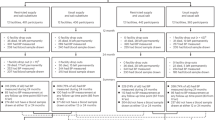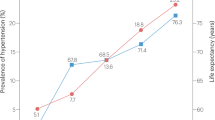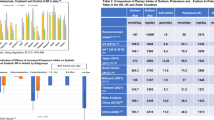Abstract
Replacement of regular salt with potassium-enriched substitutes reduces blood pressure in controlled situations, mainly among people with hypertension. We report on a population-wide implementation of this strategy in a stepped-wedge cluster randomized trial (NCT01960972). The regular salt in enrolled households was retrieved and replaced, free of charge, with a combination of 75% NaCl and 25% KCl. A total of 2,376 participants were enrolled in 6 villages in Tumbes, Peru. The fully adjusted intention-to-treat analysis showed an average reduction of 1.29 mm Hg (95% confidence interval (95% CI) (−2.17, −0.41)) in systolic and 0.76 mm Hg (95% CI (−1.39, −0.13)) in diastolic blood pressure. Among participants without hypertension at baseline, in the time- and cluster-adjusted model, the use of the salt substitute was associated with a 51% (95% CI (29%, 66%)) reduced risk of developing hypertension compared with the control group. In 24-h urine samples, there was no evidence of differences in sodium levels (mean difference 0.01; 95% CI (0.25, −0.23)), but potassium levels were higher at the end of the study than at baseline (mean difference 0.63; 95% CI (0.78, 0.47)). Our results support a case for implementing a pragmatic, population-wide, salt-substitution strategy for reducing blood pressure and hypertension incidence.
This is a preview of subscription content, access via your institution
Access options
Access Nature and 54 other Nature Portfolio journals
Get Nature+, our best-value online-access subscription
$32.99 / 30 days
cancel any time
Subscribe to this journal
Receive 12 print issues and online access
$259.00 per year
only $21.58 per issue
Buy this article
- Purchase on SpringerLink
- Instant access to full article PDF
Prices may be subject to local taxes which are calculated during checkout



Similar content being viewed by others
Data availability
Anonymized clinical and anthropometric data are available on request, subject to an internal review by J.J.M., R.H.G. and A.B.-O. to ensure that the participants’ anonymity and confidentiality are protected, with completion of a data-sharing agreement, and in accordance with the Universidad Peruana Cayetano Heredia and Johns Hopkins University’s institutional review boards and institutional guidelines. Material requests, that is marketing campaign information or economics data requests, will be considered based on a proposal review, and completion of a material transfer agreement and/or a data use agreement. Please submit requests for participant-related clinical and other data to A.B.-O. (Antonio.Bernabe@upch.pe), copying to J.J.M. (Jaime.Miranda@upch.pe).
References
Wang, G. & Bowman, B. A. Recent economic evaluations of interventions to prevent cardiovascular disease by reducing sodium intake. Curr. Atheroscler. Rep. 15, 349 (2013).
Salt Reduction: Fact Sheet (World Health Organization, 2016); https://www.who.int/news-room/fact-sheets/detail/salt-reduction
Kontis V. et al. Three public health interventions could save 94 million lives in 25 years global impact assessment analysis. Circulation 140, 715–725 (2019).
Melander, O. et al. Moderate salt restriction effectively lowers blood pressure and degree of salt sensitivity is related to baseline concentration of renin and N-terminal atrial natriuretic peptide in plasma. J. Hypertens. 25, 619–627 (2007).
Murray, C. J. et al. Effectiveness and costs of interventions to lower systolic blood pressure and cholesterol: a global and regional analysis on reduction of cardiovascular-disease risk. Lancet 361, 717–725 (2003).
Sacks, F. M. et al. Effects on blood pressure of reduced dietary sodium and the dietary approaches to stop hypertension (DASH) diet. DASH-Sodium Collaborative Research Group. N. Engl. J. Med. 344, 3–10 (2001).
He, F. J., Li, J. & Macgregor, G. A. Effect of longer term modest salt reduction on blood pressure: Cochrane systematic review and meta-analysis of randomised trials. BMJ 346, f1325 (2013).
Trieu, K. et al. Review of behaviour change interventions to reduce population salt intake. Int. J. Behav. Nutr. Phys. Act. 14, 17 (2017).
China Salt Substitute Study Collaborative Group. Salt substitution: a low-cost strategy for blood pressure control among rural Chinese. A randomized, controlled trial. J. Hypertens. 25, 2011–2018 (2007).
Geleijnse, J. M., Witteman, J. C., Bak, A. A., den Breeijen, J. H. & Grobbee, D. E. Reduction in blood pressure with a low sodium, high potassium, high magnesium salt in older subjects with mild to moderate hypertension. BMJ 309, 436–440 (1994).
Zhou, B. et al. Long-term effects of salt substitution on blood pressure in a rural north Chinese population. J. Hum. Hypertens. 27, 427–433 (2013).
Peng, Y. G. et al. Effects of salt substitutes on blood pressure: a meta-analysis of randomized controlled trials. Am. J. Clin. Nutr. 100, 1448–1454 (2014).
Li, N. et al. The effects of a community-based sodium reduction program in rural China—a cluster-randomized trial. PLoS ONE 11, e0166620 (2016).
Trieu, K. et al. Salt reduction initiatives around the world—a systematic review of progress towards the global target. PLoS ONE 10, e0130247 (2015).
NCD Risk Factor Collaboration. Worldwide trends in blood pressure from 1975 to 2015: a pooled analysis of 1479 population-based measurement studies with 19.1 million participants. Lancet 389, 37–55 (2017).
Lewington, S. et al. Age-specific relevance of usual blood pressure to vascular mortality: a meta-analysis of individual data for one million adults in 61 prospective studies. Lancet 360, 1903–1913 (2002).
Rose, G. Sick individuals and sick populations. Int. J. Epidemiol. 14, 32–38 (1985).
Hu, J., Zhao, L., Thompson, B., Zhang, Y. & Wu, Y. Effects of salt substitute on home blood pressure differs according to age and degree of blood pressure in hypertensive patients and their families. Clin. Exp. Hypertens. 40, 664–672 (2018).
Saavedra-Garcia, L. et al. Applying the triangle taste test to assess differences between low sodium salts and common salt: evidence from Peru. PLoS ONE 10, e0134700 (2015).
Binia, A., Jaeger, J., Hu, Y., Singh, A. & Zimmermann, D. Daily potassium intake and sodium-to-potassium ratio in the reduction of blood pressure: a meta-analysis of randomized controlled trials. J. Hypertens. 33, 1509–1520 (2015).
Mente, A. et al. Urinary sodium excretion, blood pressure, cardiovascular disease, and mortality: a community-level prospective epidemiological cohort study. Lancet 392, 496–506 (2018).
Poorolajal, J. et al. Oral potassium supplementation for management of essential hypertension: a meta-analysis of randomized controlled trials. PLoS ONE 12, e0174967 (2017).
Filippini, T., Violi, F., D’Amico, R. & Vinceti, M. The effect of potassium supplementation on blood pressure in hypertensive subjects: a systematic review and meta-analysis. Int. J. Cardiol. 230, 127–135 (2017).
Perez, V. & Chang, E. T. Sodium-to-potassium ratio and blood pressure, hypertension, and related factors. Adv. Nutr. 5, 712–741 (2014).
Attaei, M. W. et al. Availability and affordability of blood pressure-lowering medicines and the effect on blood pressure control in high-income, middle-income, and low-income countries: an analysis of the PURE study data. Lancet Public Health 2, e411–e419 (2017).
Whelton, P. K. et al. 2017 ACC/AHA/AAPA/ABC/ACPM/AGS/APhA/ASH/ASPC/NMA/PCNA guideline for the prevention, detection, evaluation, and management of high blood pressure in adults: executive summary: a report of the American College of Cardiology/American Heart Association Task Force on Clinical Practice Guidelines. J. Am. Coll. Cardiol. 71, 2199–2269 (2018).
Aminde, L. N., Takah, N. F., Zapata-Diomedi, B. & Veerman, J. L. Primary and secondary prevention interventions for cardiovascular disease in low-income and middle-income countries: a systematic review of economic evaluations. Cost Eff. Resour. Alloc. 16, 22 (2018).
Garret J. L. Comedores Populares: Lessons For Urban Programming From Peruvian Community Kitchens (CARE-USA, 2001).
Bernabe-Ortiz, A. et al. Launching a salt substitute to reduce blood pressure at the population level: a cluster randomized stepped wedge trial in Peru. Trials 15, 93 (2014).
Campbell, M. K., Piaggio, G., Elbourne, D. R. & Altman, D. G. Consort 2010 statement: extension to cluster randomised trials. BMJ 345, e5661 (2012).
Davey, C. et al. Analysis and reporting of stepped wedge randomised controlled trials: synthesis and critical appraisal of published studies, 2010 to 2014. Trials 16, 358 (2015).
Hemming, K., Haines, T. P., Chilton, P. J., Girling, A. J. & Lilford, R. J. The stepped wedge cluster randomised trial: rationale, design, analysis, and reporting. BMJ 350, h391 (2015).
Brown, C. A. & Lilford, R. J. The stepped wedge trial design: a systematic review. BMC Med. Res. Methodol. 6, 54 (2006).
Bernabe-Ortiz, A. et al. Contribution of modifiable risk factors for hypertension and type-2 diabetes in Peruvian resource-limited settings. J. Epidemiol. Commun. Health 70, 49–55 (2016).
Bernabe-Ortiz, A. et al. Impact of urbanisation and altitude on the incidence of, and risk factors for, hypertension. Heart 103, 827–833 (2017).
Censos Nacionales 2017: XI de Población y VI de Vivienda (Instituto Nacional de Estadistica e Informatica, 2017); http://www.inei.gob.pe/estadisticas/censos
French J., Blair-Stevens C., Merritt R. & McVey D. Social Marketing and Public Health: Theory and practice (Oxford Univ. Press, 2010).
Pretell, E. A. & Higa, A. M. Peru celebrates 25 years of sustained elimination of IDD. IDD Newsl. 31, 12–14 (2009).
Coleman, A., Steel, S., Freeman, P., de Greeff, A. & Shennan, A. Validation of the Omron M7 (HEM-780-E) oscillometric blood pressure monitoring device according to the British Hypertension Society protocol. Blood Press. Monit. 13, 49–54 (2008).
Chobanian, A. V. et al. The seventh report of the joint national committee on prevention, detection, evaluation, and treatment of high blood pressure: the JNC 7 report. JAMA 289, 2560–2572 (2003).
R Core Team. A Language and Environment for Statistical Computing (R Foundation for Statistical Computing, 2019); https://www.R-project.org
Hughes, J. P., Granston, T. S. & Heagerty, P. J. Current issues in the design and analysis of stepped wedge trials. Contemp. Clin. Trials 45(Pt A), 55–60 (2015).
Scott, J. M., deCamp, A., Juraska, M., Fay, M. P. & Gilbert, P. B. Finite-sample corrected generalized estimating equation of population average treatment effects in stepped wedge cluster randomized trials. Stat. Methods Med. Res. 26, 583–597 (2017).
Durovni, B. et al. Effect of improved tuberculosis screening and isoniazid preventive therapy on incidence of tuberculosis and death in patients with HIV in clinics in Rio de Janeiro, Brazil: a stepped wedge, cluster-randomised trial. Lancet Infect. Dis. 13, 852–858 (2013).
Schoenfeld, D. Partial residuals for the proportional hazards regression model. Biometrika 69, 239–241 (1982).
Stolarz-Skrzypek, K. et al. Fatal and nonfatal outcomes, incidence of hypertension, and blood pressure changes in relation to urinary sodium excretion. JAMA 305, 1777–1785 (2011).
Swanepoel, B., Schutte, A. E., Cockeran, M., Steyn, K. & Wentzel-Viljoen, E. Sodium and potassium intake in South Africa: an evaluation of 24-hour urine collections in a white, black, and Indian population. J. Am. Soc. Hypertens. 10, 829–837 (2016).
Acknowledgements
This study was supported by the National Heart, Lung and Blood Institute (Project 5 U01 HL114180-01), under the Global Alliance for Chronic Diseases hypertension program. A.B.-O. was supported by a Wellcome Trust Research Training Fellowship in Public Health and Tropical Medicine (grant no. 103994/Z/14/Z). V.G.S.y.R. was funded by the Dirección de Gestión de la Investigación at the Pontifica Universidad Católica del Perú (grant no. DGI-2017-496).
Author information
Authors and Affiliations
Contributions
A.B.-O. and J.J.M. drafted the first version of the manuscript. R.M.C.-L. provided input to this version of the manuscript. A.B.-O., R.H.G., K.A.S. and J.J.M. conceived and designed the overall study. V.G.S.y.R. and A.B.-O. developed the statistical analysis plan and conducted the statistical analysis. V.P.-L. led the social marketing campaign. M.K.C. designed the strategy for the cost-effectiveness analysis. F.D.-C. and M.A.P. conducted qualitative work during the intervention as part of a process evaluation. All the authors contributed to the revision of the manuscript for important content and gave their final approval of the version submitted for publication.
Corresponding author
Ethics declarations
Competing interests
The authors declare no competing interests.
Additional information
Peer review information Jennifer Sargent was the primary editor on this article and managed its editorial process and peer review in collaboration with the rest of the editorial team.
Publisher’s note Springer Nature remains neutral with regard to jurisdictional claims in published maps and institutional affiliations.
Extended data
Extended Data Fig. 1 Trends in mean SBP and their respective 95% confidence intervals by village and intervention period.
Blue symbols and lines indicate measurements and time before institution of the study intervention, and brown symbols and lines represent the intervention time periods. Time periods are 5-month analysis periods occurring before the initiation of the intervention in each wave.
Extended Data Fig. 2 Trends in mean DBP and their respective 95% confidence intervals by village and intervention period.
Blue symbols and lines indicate measurements and time before institution of the study intervention, and brown symbols and lines represent the intervention time periods. Time periods are 5-month analysis periods occurring before the initiation of the intervention in each wave.
Extended Data Fig. 3 Cumulative probability of developing hypertension in the intervention and control group during the duration of the study.
Probability of developing hypertension in the intervention and control groups.
Supplementary information
Supplementary Information
Supplementary Tables 1–4 and Statistical analysis
Rights and permissions
About this article
Cite this article
Bernabe-Ortiz, A., Sal y Rosas, V.G., Ponce-Lucero, V. et al. Effect of salt substitution on community-wide blood pressure and hypertension incidence. Nat Med 26, 374–378 (2020). https://doi.org/10.1038/s41591-020-0754-2
Received:
Accepted:
Published:
Issue date:
DOI: https://doi.org/10.1038/s41591-020-0754-2
This article is cited by
-
Lifestyle modifications and control of cardiovascular risk factors in older adults with hypertension: from NHANES 1999–2018
BMC Geriatrics (2025)
-
Stakeholder perspectives on scaling up potassium-enriched salt to reduce cardiovascular disease in Australia: a qualitative study
BMC Public Health (2025)
-
Effect of population-based sodium reduction interventions on blood pressure: a systematic review and meta-analysis of randomized trials
Hypertension Research (2025)
-
Effects of salt substitution on cumulative blood pressure: a secondary analysis of the SSaSS
European Journal of Epidemiology (2025)
-
A pathway to UHC for Odisha
Discover Health Systems (2025)



